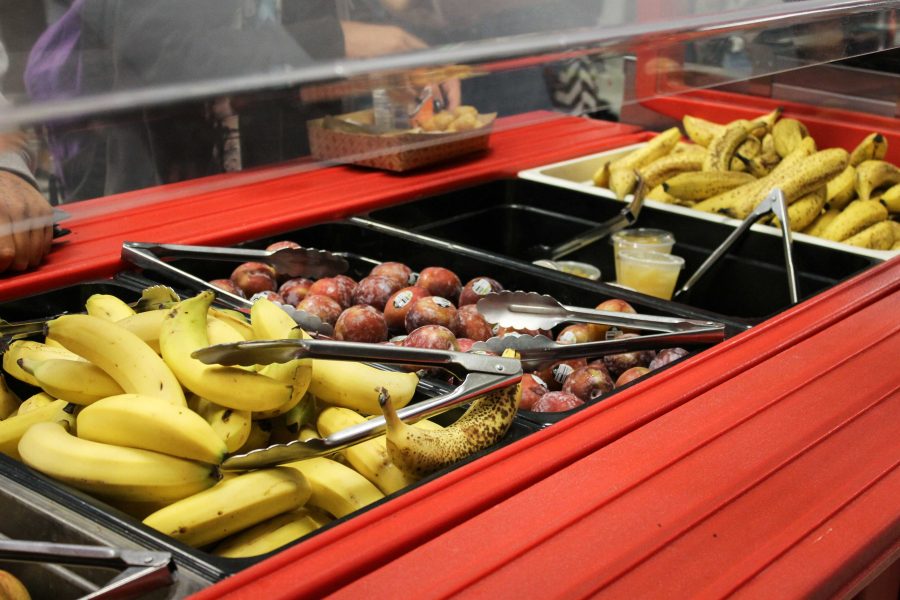
[dropcap size=dropcap]T[/dropcap]his summer, new federal regulations for food in school were enacted nationwide. The regulations apply to cafeteria food and vending machine snacks sold at school. They also affect items given away at schools, such as Gatorade products during “G-Week.”
These changes were due to the new Smart Snacks in Schools Rule, which outlines the required nutritional content for various types of food sold in schools.
This new set of federal guidelines was enacted on July 1 of this year in all United States school districts. Created by the United States Department of Agriculture (USDA), the guidelines aim to promote healthy eating in public schools.
The standards specified requirements for snacks (such as chips, nuts, or granola bars), beverages, sides (items served with an entree, such as mashed potatoes, french fries, or steamed vegetables), and entrees.
Foothill applied for and was selected for what is known as “G-Week,” which occurred the second week of school.
As part of G-Week, Gatorade gave Foothill different types of sports coolers for drinks, along with samples of their products to distribute to student athletes. These products were energy chews, whey protein bars, and protein shakes. Some students voluntarily chose to sample the products.
Of the three items Gatorade distributed to students, none pass the new federal guidelines, according to the information from the Smart Snacks calculator.
“[The nutritional content] is something we were a little bit concerned about,” Foothill principal Joe Bova said.
Ventura Unified’s Wellness Policy expands federal guidelines by saying “All foods and beverages available to students […] shall meet or exceed state and federal nutrition standards.” Food distributed or sold to students needs to adhere to federal standards.
According to the USDA, foods that do not comply with the standards may be sold from one half hour after school through midnight.
The Gatorade products were distributed to student athletes before and after their workouts for a few days between 2 pm and 3 pm, which is counted as part of the school day.
The Smart Snacks in School nutrition standards help make the healthy choice the easy choice for America’s youth http://t.co/S0rBIPrSkM
— USDA Team Nutrition (@TeamNutrition) May 14, 2014
Junior Kailey Schuyler expressed concern about the ingredients in the “Gatorade Prime Energy Chews.”
“It’s just instinct, I always look at the ingredients of things, and like I said, the first two ingredients were like corn syrup and then sugar and I was like, ‘Please tell me, is this healthy energy? Is this the energy I should be consuming before I work out?’” Schuyler said. “The rest of the ingredients were just things I couldn’t pronounce.”
Schuyler said she, as well as some of her friends, had “body problems” after eating the products, but wasn’t sure if the products were the cause.
“I had like an asthma attack. I don’t know if this was induced by the food, but I had eaten the food before I worked out. […] I couldn’t breathe, and every time I breathed it wasn’t enough breath,” she said. “It might be a coincidence that it all happened on the day we ate this food they gave us, but it could not be.”
Junior Cody Clark tried the energy chews and “got a sugar rush” from them, then had a bad headache after practice.
“The guy at the Gatorade rally tried to justify it and say that it’s all coming from carbohydrates, but if you look into it, it’s all just sugar,” he said.
“It’s nice that they’re sponsoring us and giving us money for our equipment, but it kinda sucks at the same time because you’re promoting a product that’s unhealthy,” Clark said.
Sophomore John Marcoux said he felt ill after several cross country practices the second week of school. He attributes this to the Gatorade products.
Several students did not have strong opinions about the products. Junior Alex Beamer, who is on the baseball team, expressed that he wasn’t sure about his stance.
“I don’t exactly hate it, but it’s not great either. They kind of didn’t tell us what was in it,” Beamer said.
Freshmen Olivia Burton enjoyed the product and said it helped her run during cross country practice.
“It [the product] does help us pretty much run. I think it gives us energy to run quick and not be tired and stressed out,” Burton said.
Bova said Buena High School and Ventura High School both have similar partnerships.
“Buena and Ventura both do a partnering with Gatorade, and they do a similar kickoff to what we did,” Bova said.
He said he thought they might have Gatorade specific vending machines on campus.
An examination last week of four vending machines each at Buena High School and Ventura High School showed that no Gatorade vending machines or non-compliant Gatorade products were present.
Kara Muniz, Director of Health and Nutrition Services at Ventura Unified School District, was not aware of “G-Week” happening at Foothill. She said that she doesn’t think the goal of the new federal standards is to punish companies distributing non-compliant foods, such as Gatorade, but is considering speaking to them about the new Smart Snacks Rule.
“I don’t think the goal of this, like I said before, is to punish people; it’s to educate them,” Muniz said. “So maybe I need to find out who arranges that, and maybe Gatorade needs to realize that we have these mandates.”
Foothill’s Gatorade representative did not respond to several calls from the Foothill Dragon Press.
Sizes of items in vending machines decreased to meet new standards
Items in the vending machines have been changed because of the new standards for snacks sold to high schoolers.
These standards are:
- No more than 35% of calories may come from fat
- Less than 10% of calories may come from saturated fat
- No more than 35% sugar by weight
- Less than .5g trans fat per serving
- No more than 230 mg sodium
- No more than 200 calories per item
A few items have been changed in the vending machines in order to meets the standards. Muniz said she personally used the calculator to check each item being sold to be sure it complied.

“Ultimately, whoever at the school level is in charge of those vending machines, they’re the ones that truly need to make sure everything is compliant,” Mike Danzik, nutrition education consultant at the California Department of Education, said.
One of the main issues that have been brought up is the size of items. In order to comply, there needed to be less sodium and fat, and fewer calories in the items. A simple way to fix this was to cut down the size.
“All the chips, the Corn Nuts, the Chex Mix, that stuff, has gotten smaller, but the cost hasn’t decreased,” Muniz said. “If there’s a real demand for it, maybe I can lower the cost a little bit.”
The snacks being used will likely be reevaluated in October.
Muniz oversaw implementation of these standards in the district, giving presentations to school principals, office managers, and the Parent Advisory Council (PAC). She says Ventura Unified is ahead of other districts in terms of applying the standards.
“We’ve always been good. We took soda out before the law came into effect. We’ve always been ahead of the curve,” she said.
Muniz said she thinks the standards are changing things for the better.
“They’re strict, but I also think it’s in the best interests of students,” she said. “We care about how they do academically, we care about how they do in sports, we need to be contributors of healthy eating and teach them that.”
Danzik agrees.
“As the Department of Education, I think we feel that [nutrition] is extremely important, probably as much as academic success. There’s a lot of research that shows a link between health and academic success, and of course we’re for both of those,” Danzik said.
Increased variety of cafeteria food gives students more choices
The Smart Snacks in Schools regulations have changed things in the cafeteria as well.
Lori Walker, cafeteria manager at Foothill, said that even though new snacks are smaller, there is more variety.
“The new guidelines kinda opened the window for us to have more choices. Since we had to re-analyze all of them, we then saw what was all available,” Walker said.
Some of these new foods include chicken alfredo, frozen slushies, and “cinnamon toasties.”
[soundcloud url=”https://api.soundcloud.com/tracks/167197751″ params=”color=c82735&auto_play=false&hide_related=false&show_comments=true&show_user=true&show_reposts=false” width=”100%” height=”166″ iframe=”true” /]
Prices have not had to change for breakfast and lunch, Muniz said, which benefits students on Free and Reduced Meals.
The Free and Reduced Meals program is aimed to help students in difficult financial situations get healthy meals from school. The state and federal government subsidize these meals, so the cost for the district is offset. However, the district receives “very little reimbursement” from the state for the paying population, Muniz said.
Even with the subsidies, it’s hard for cafeteria staff to craft meals that fit the price range.
“Its tough in this district because we’re close to 50 percent free and reduced,” Muniz said.
Fidelity Ballmer contributed to the reporting of this article










fellow student journalist • May 23, 2015 at 2:28 pm
congrats on the award!
Mrs Vega • Sep 29, 2014 at 6:01 pm
Do the guidelines open the way for more vegan or vegetarian options?
Alumni • Sep 28, 2014 at 10:44 pm
Yeah Gatorade isn’t good for you. It has as much sugar in a serving as a soda. Also, it’s only recommended for people who do long distance exercise like biking, marathons, etc. (and people who have to have colonoscopies! Lol)
anonymous • Sep 28, 2014 at 7:04 pm
“The guy at the Gatorade rally tried to justify it and say that its all coming from carbohydrates, but if you look into it, it’s all just sugar,”
Sugar is a carbohydrate…..